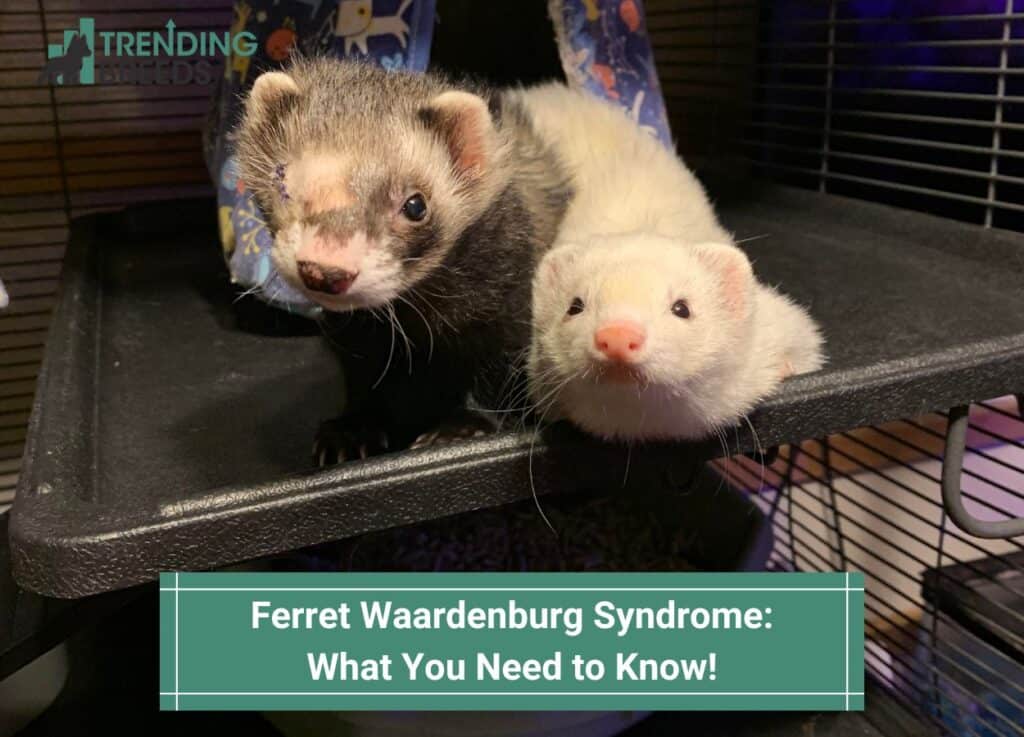
Ferret Waardenburg Syndrome is an extremely rare genetic disorder that affects the pigmentation of a ferret’s eyes, skin, and hair.
While commonly found in humans, the syndrome affects other animals too.
Therefore, it is important to recognize the severity and scope of Waardenburg syndrome in ferrets can differ substantially from the human condition.
In this article, we’re going to go over Ferret Waardenburg Syndrome in ferrets and also debunk some myths of the condition.
Before you scroll further down this guide, check out these other ferret-related articles: Ferrets for Sale in San Antonio – Top Breeders and Can Ferrets Wear Diapers?.
Why Is Waardenburg Talked About In Ferrets?

Waardenburg Syndrome in ferrets is brought up in conversations about feeding and pigmentation.
It also is commonly discussed by veterinarians who specialize in exotic animals. While this condition is not fatal, it does result in distinct physical traits.
This condition has also become somewhat of a fascination in ferret communities.
These traits are often considered unique or cute without understanding that the condition is much more serious, as they indicate genetic disorders.
Humans vs. Ferret
Waardenburg Syndrome has different conditions in humans and ferrets.
In humans, it leads to deafness and heterochromia – a difference in eye color.
In ferrets, however, the syndrome produces white or patchy coats, blue eyes, and hearing loss.
More severe types in ferrets also include limb deformities and gastrointestinal issues.
What Is Ferret Waardenburg Syndrome?

Classified by Dutch ophthalmologist Petrus Johannes Wardenburg in 1951, Waardenburg Syndrome is a rare genetic disorder.
Characterized by degrees of deafness, minor defects in structures that arise from the natural crest, and pigmentation anomalies affecting the eye, hair, and skin.
Is Ferret Waardenburg Syndorme Genetic?

Yes, Waardenburg Syndrome in ferrets is generally a genetic condition.
It is inherited in an autosomal dominant manner. This means that one copy of the mutated gene from either parent is enough to cause this syndrome.
Different types of the syndrome are associated with gene mutations, such as PAX3, MITF, and SOX10.
If one parent ferret has Waardenburg Syndrome, there’s a 50% chance that their offspring will inherit this condition as well.
How Is Waardenburg Syndrome Classified?

The syndrome is categorized into four types (Type I to IV), based on additional symptoms and patterns.
All of these share some degree of hearing loss and pigmentation changes.
However, these may vary significantly in the presence of other features like limb anomalies or intestinal disorders.
Here’s a breakdown of the differences between Type I, II, III, and Type IV in ferrets.
Type I Waardenburg Syndrome
Type I is typically the least severe form and is often caused by mutations in the PAX3 gene. Symptoms include the following:
- Blue eyes or heterochromia (different colored eyes)
- A white stripe running down the forehead and nose (blaze)
- Sensorineural hearing loss
It is usually diagnosed through clinical signs and potentially genetic testing.
Management is primarily supportive, focusing on dealing with hearing loss, if present.
Type II Waardenburg Syndrome

The MITF gene is generally present in Type II. Symptoms include this:
- Sensorineural hearing loss
- More pronounced pigmentation anomalies, such as more extensive white markings on the face and body
These symptoms are similar to Type I but are much more extensive.
Clinical diagnosis of this type is much more straightforward with genetic testing that can confirm it. Treatment for this is also symptomatic.
Type III Waardenburg Syndrome
Known as Klein-Waardenburg Syndrome, it involves mutations in the PAX3 gene, like the Type I we’ve discussed previously.
However, this syndrome has much more severe manifestations. Symptoms include the following:
- Every symptom present in Type I
- Additional abnormalities, such as limb deformities and fused vertebrae as well.
Because of the aforementioned musculoskeletal abnormalities, X-rays and other imaging studies are generally used for diagnosis.
Treatment will also include surgical intervention for limb deformities as well as symptomatic care for other features as well.
Type IV Waardenburg Syndrome

Known as Waardenburg-Shah Syndrome, Type IV indicates activity in the SOX10 gene or the EDN3 gene.
This is the most severe form of Waardenburg Syndrome. Naturally, symptoms include the following:
- All the features of Type II
- A multitude of gastrointestinal issues. This is because there are some nerve cells in the colon that are now not present (Hrischsprung disease.)
Since this is the most severe form of Waardenburg syndrome, the diagnosis will involve imaging and biopsy of the colon alongside other tests as well.
Treatments will also include surgical removal of the affected part of the colon.
Can a Ferret With Waardenburg Syndrome Breed?

Yes, a ferret with Waardenburg Syndrome can breed. However, there are certain ethical considerations that must be taken into account before breeding a ferret with this condition.
Breeding a ferret with Waardenburg increases the likelihood of producing offspring with the same condition.
As such, almost all medical professionals and experts recommend against breeding ferrets with genetic disorders as it will perpetuate health issues within the population.
Therefore, you should not breed a ferret with this condition.
How Long Does a Ferret With Waardenburg Syndrome Live?

The lifespan of a ferret with Waardenburg Syndrome depends on how severe its symptoms are. There is no hard and fast rule.
Conversely, the syndrome does not have a direct impact on the lifespan as well.
The severity of these symptoms, like hearing impairment, intestinal issues, or other health-related concerns, may indirectly affect the quality of life and thus potentially impact longevity as well.
What To Do If My Ferret Has Waardenburg Syndrome?

The first step in managing Waardenburg Syndrome is finding a qualified veterinarian experienced in treating this specific condition.
Online forums and local ferret communities can be helpful resources for recommendations.
Here are a few we recommend:
Routine visits are critical for monitoring your ferret’s condition and adjusting its treatment as necessary.
Your veterinarian will usually conduct tests and may adjust medications or dietary plans based on the results.
How to Manage and Treat a Ferret with Waardenburg Syndrome

If you have a ferret who has Waardenburg Syndrome, you’ll have to manage and treat your ferret in a bit of an unorthodox manner:
- Dietary Adjustments: One of the primary ways to manage Waardenburg Syndrome in ferrets is through a specialized diet. Certain nutrients and vitamins can alleviate some of the symptoms.
- Medication: Depending on the severity of your symptoms, medication may be prescribed to manage your ferret’s condition. This could range from nutritional supplements to prescription medications for more severe symptoms.
- Environmental Modifications: Your ferret’s living environment may require changes to manage symptoms better. This can include everything from the layout of their cage to the type of bedding used. Every detail matters here.
All in all, changing your ferret’s diet and consulting your vet for medication are key changes that you need to take into account if your ferret has Waardenburg Syndrome.
Since this disease is genetic, there is no real treatment for it. Depending on the symptoms presented, such as deformed limbs, surgical intervention is the preferred method for treatment.
Psychological Aspects
Waardenburg Syndrome can lead to behavioral changes in your ferret as well.
Early identification and appropriate intervention are also crucial for your pet’s well being.
- Socializing Your Ferret: Social interaction can be a significant aspect of your ferret’s mental well-being. Creating a stimulating environment and providing opportunities for interaction can make a world of difference.
- Mental Stimulation: Ensuring that your ferret is mentally stimulated can go a long way in managing symptoms as well. Toys, puzzle feeders, and regular playtime are great ways you can achieve this for your ferret.
The Family’s Role

If you have children, educate them about Waardenburg Syndrome.
This will help ensure they interact appropriately with your ferret, taking into consideration its needs.
Moreover, other pets in the household, especially aggressive breeds, need to be managed carefully.
Plus, regular exercise is essential for your ferret’s well-being, and knowing which activities are age-appropriate can greatly benefit their health.
Certain exercises that are extremely strenuous or require excessive limb movement can be harmful to your ferret, especially if they suffer from Type IV or Type II.
Ongoing Care and Finances
Managing Waardenburg Syndrome in your ferret is a long-term commitment that requires ongoing care and periodic adjustments to your ferret’s treatment plan.
The financial aspect of managing a ferret with Waardenburg Syndrome can’t also be overlooked.
You’ll need to budget for treatment, medications, and possible emergency care as well.
Pet insurance policies that cover genetic conditions can help mitigate costs. You should research and choose a policy that best suits your needs.
As we’ve mentioned, numerous online forums and social media groups dedicated to ferret care can help provide you with a more hands-on idea about the disease while local support groups can aid in the financial aspect of things.
Ferret Waardenburg Syndrome: What You Need to Know

Ferret Waardenburg Syndrome, while rare, can greatly affect your ferret’s health, especially if it is of a more severe type.
So, if you spot any of the symptoms, refer to a vet immediately.
Thankfully, regardless of the condition, your ferret can live a happy and full life, given that you take all of the precautions we’ve mentioned into regard.
If you find this guide, “Ferret Waardenburg Syndrome: What You Need to Know,” informative and helpful, you can check out these other ferret-related articles from our team:
- Ferrets for Sale in Dallas – Top Breeders
- Ferrets for Sale in Houston – Top Breeders
- Ferrets for Sale in Kansas City – Top Breeders
You can learn more about this topic by watching “Waardenburg Syndrome in Ferrets” down below:




